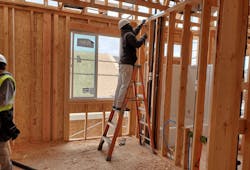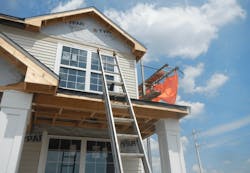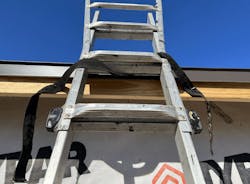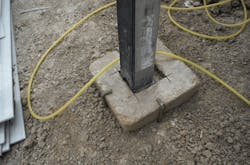In general, falls remain a leading cause of unintentional injury and mortality nationwide, and 43% of fatal falls during the last decade involve a ladder. Each year, 150,000 people are involved in a ladder-related accident and nearly 100 people die from ladder-related injuries. No family should suffer the loss of their loved one because of improper ladder use.
Beyond the human cost, the estimated annual financial impact of ladder-related injuries is $11 billion from lost work wages and medical, legal, liability, and pain and suffering expenses. On average, a single ladder accident costs an employer $80,000—roughly the price of a new, top-of-the-line Ford F-350 Super Duty truck.
RELATED
- Construction Site Fall Protection Made Simple
- OSHA Offers Enforcement Update
- Don’t Cut Corners on Construction Jobsite Safety
General Safety Measures for Ladders: A-Frame Ladders, Extension Ladders, and Pump Jacks
The first step (no pun intended!) in reducing the human and business costs of ladder-related incidents is to ensure all workers are properly trained and educated on the use of extension ladders, A-frame ladders, and pump jacks.
Consider these basic (but critical) safety measures for all three types, as well as some specific tips for each one.
Signs of damage. Before each use, inspect the ladder or jack components for any signs of damage, such as bent or cracked rungs, loose hardware, split or bent rails, cracked platforms, and nonworking lift mechanisms. If you find any damage, immediately take the tool out of service for repair or replacement.
Choose the right tool. Verify that an extension or A-frame ladder’s length or maximum height is adequate to reach the work area safely.
Stability. Ladders and jacks should be set on stable, level surfaces and be capable of supporting the weight and movement of workers and materials. For extension ladders, use levelers or leg extensions on uneven terrain; for A-frames, make sure spreaders and locking mechanisms are engaged and secure; for pump jacks, base plates or poles should be firmly anchored to the ground and the building structure.
Weight limit. Every ladder and pump jack has a weight limit or load capacity (“duty rating”)—typically marked on the ladder or jack—that should never be exceeded. Consider the weight of not just yourself (and other workers on the pump jack), but also the weight of your tools and materials.
Tools and materials. Use toolbelts or buckets to carry or hoist tools and materials, keeping both hands free for climbing and maintaining balance.
Don’t overreach. On extension and A-frame ladders, a good rule of thumb is to keep your belt buckle within the ladder’s side rails. If you can’t reach a specific area without breaking that rule or causing the ladder to tip, descend and move the ladder into better position.
Specific Tips for Ladder Safety
Tips for Working Safely on Extension Ladders
For extension ladders, the top of the ladder should clear the work surface by 3 feet and be secured to the building structure with an approved strap to prevent movement.
Place extension ladders at a 75-degree angle to mitigate slipping and tipping, and always maintain three points of contact—two hands and one foot or two feet and one hand—when ascending or descending the ladder.
Tips for Working Safely With Pump Jacks
Pump jacks enable workers to reach elevated areas for tasks such as siding and window installation. The key difference between pump jacks and traditional ladders is that they have to be assembled and broken down (like scaffolding) and must be more securely rooted to the ground or another solid surface in order to use them safely.
When assembling pump jacks, follow manufacturer instructions carefully and ensure all components are securely connected before adjusting the system to the height at which you can work safely.
Always use a stable, secure work platform (such as scaffold planks) and make sure that platform is level and free from debris or tripping hazards. Use guardrails on the platform to prevent workers from accidentally falling off and toe boards to prevent tools or materials from falling off the working surface to the area below. Workers also should use personal fall protection equipment, such as harnesses and lanyards, when working at heights.
RELATED: Safe Scaffolding: Follow These Best Practices for Correct Setup
With that, netting systems serve to catch falling objects, debris, or tools from dropping to lower levels or the ground, which can pose a hazard to workers or bystanders below (see main image, above). Safety netting material is often made from durable nylon or polyethylene and includes attachment hardware, such as hooks, clips, or fasteners, to secure the netting to the pump jack scaffolding planks or the building structure.
It is crucial to prioritize safety by following proper procedures, inspecting equipment regularly, and using appropriate personal safety gear. Protecting the lives of those who build homes should be a top priority, and safety should never be overlooked.
Sean McClain drives quality and performance in home building as a building performance specialist on the PERFORM Builder Solutions team at IBACOS.





